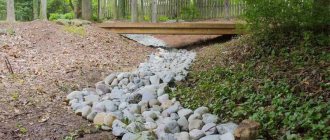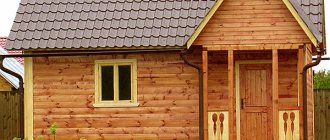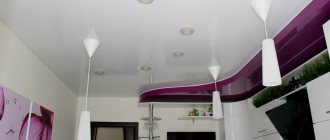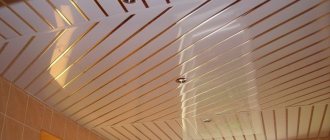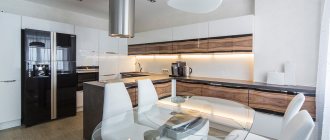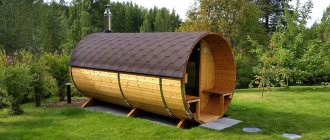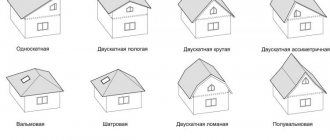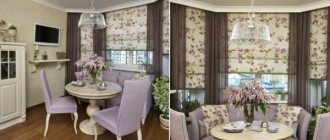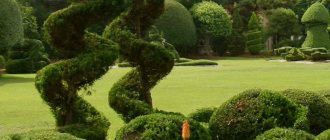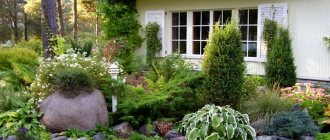A little history
The use of small architectural forms began in the Renaissance, when landscape gardening ensembles became widespread in Europe. Specialists of various levels worked on their creation: from a simple gardener to a famous architect or sculptor.
In the countries of the East, since ancient times, small architectural forms have been an integral part of gardens of contemplation.
Decorative fountains, pagodas, compositions made of stones - all these design elements not only had a symbolic meaning, but also contributed to creating a mood of calm and tranquility.
In Rus' they have always loved working with wood. Carved pillars with fancy figures of animals and birds. Figures of epic heroes. Benches. Wells. All this will later be adopted by landscape designers in their work.
Features of MAFs
Let's look at the definition of small architectural forms (MAFs).
MAFs, or small architectural forms, are compact structures that create a special atmosphere in open spaces; they also often serve a specific purpose.
Small forms of architectural structures are often used when decorating garden areas, paths and other unoccupied spaces. By installing such elements, accents are placed in the garden (most often sculptures are used for this purpose), the main areas are emphasized (usually through arches), and a comfortable environment is created for long rest (benches and gazebos are used).
The appearance of MAFs is of great importance: it is important that the design fits into the natural landscape, is conducive to relaxation, looks not only aesthetically pleasing, but also contributes to the creation of comfort. The best option is to use hand-made structures rather than purchased ones to decorate the site - to create a special comfort zone during construction you will have to be creative.
What their design will be is up to you. First you need to understand what the concept of small architectural forms includes and become familiar with their varieties.
Purpose
Small architectural forms should not only add variety to the decor of the garden, but also perform practical functions.
You can sit on a comfortable bench, a gazebo entwined with greenery will save you from the scorching sun on a hot day, and a pergola will become a support for climbing plants.
What are small architectural forms
Small architectural forms, abbreviated as MAF, are used in the improvement and design of various sites and territories. What we see in modern dacha areas are examples of MAFs. These can be lanterns, fountains, gazebos, artistic masonry, benches, decorative stones, sculptures, various bridges and other decorative elements.
MAFs are additional structures that play a significant functional and decorative role in the design of the territory in landscape design. Elements can serve completely different functions, and most importantly, small architectural forms will instantly introduce new notes of style and comfort into the park landscape. LFAs can also be a solution to the question of how to improve a dacha. Just use the MAF for your dacha.
Material
Decorative elements in a garden plot must be of high quality, but they do not necessarily have to be expensive.
To create them, you can contact a specialist, or you can do it yourself. In this case, a creative approach is encouraged, which is manifested in the originality of the design and the selection of unusual materials.
For small architectural forms you can use the classics: metal, wood, brick, stone (natural and artificial). Or you can find a use for old unnecessary things or even garbage.
You can look for ideas for decorating a garden plot in magazines for gardeners, where a huge number of photos of small architectural forms are presented. Or look through the pages of the Internet.
Classification of architectural forms
So, as you can see, one of the main tasks of small forms is to successfully complement and transform existing buildings located in the garden area. It is important to take into account absolutely all aspects: convenience, unusual design, shape and material. After all, they must fit quite well into the overall picture of the surrounding landscape. In view of this, designers working in this direction figuratively divide all known architectural forms into certain groups.
According to their functional purpose:
MAFs for determining the territorial border
On any site, when designing the proposed design, attention is always paid to the territory that needs to be separated (a recreation area and a work area) or, for example, aesthetically veiled (outbuildings, work equipment, etc.). In such cases, they often resort to the help of, for example, decorative fences of various types; bridges or arches; stairs, fountains; small retaining walls are no exception; and also, flowerpots, topiaries, and statues are often installed. Any of the above elements will be able to successfully delimit the desired zones in the garden plot, while perfectly preserving and emphasizing its style direction and uniqueness. Especially often recently, the desired results are achieved thanks to topiaries - unusual garden figures created from trees and shrubs.
A hedge has both an aesthetic and practical function.
MAFs for the recreation area
Not a single personal plot is complete without such a zone, and therefore its transformation plays an important role. As an option, they use furniture for the garden or cottage; construct areas for sports or children's games; install gazebos, benches, swings, barbecues and other decorative elements.
MAFs for convenience
The installation of these MAFs is primarily aimed at making rest or spending time in a particular place in the garden pleasant, comfortable and convenient. To do this, use flashlights or various reflective devices; drinking water fountains to relieve thirst; trash cans.
Cozy quiet corner in the garden
Classification of MAFs depending on the use of plants
To begin with, it is worth noting that when designing all MAFs, they can be divided into those that include plants in their design, and those that are created without beautiful representatives of the flora. Examples of the last category have been briefly described above, but the representatives of the first group are worth paying close attention to. So, if we divide them into several types, we can distinguish the following:
Trellis
This is a metal or wooden structure whose main purpose is to support climbing vegetation. Quite often, a garden trellis acts as a small, lightweight trellis. This invention is one of the most accessible and widespread. This is not an exaggeration, because this relatively miniature design is striking in its versatility. During the period when climbing plants entwine this garden invention, it is very similar to a thick blanket that can protect from the scorching rays of the sun. In this case, you can, as they say, “kill two birds with one stone”: hide in the shade and relax pleasantly, enjoying the aromas of the flower cover. And if you combine several trellis bars, you will get a very beautiful green gazebo. Considering that in the summer the trellis will be shrouded in vegetation, you don’t have to focus too much on the trellis pattern. By the way, when constructing this device, any gardener can successfully hide courtyard buildings that are in an unsightly condition.
Trellis in the garden
Pergolas
Among small architectural forms, this is another representative of the supporting structure. Most often, the main purpose of this invention is considered to be the delimitation of garden territory, however, during the period when pergolas are densely entwined with plants, they are in no way inferior in beauty to the above-mentioned architectural form.
Generally speaking, a pergola is a small canopy consisting of a lattice surrounded by climbing plants. This support is an excellent alternative to a roof.
The main elements are arched structures connected by special bridges. If you properly organize the arrangement of the pergola and think through the selection of vegetation, then in the end you can get a simple but quite attractive green corridor or a cozy gazebo. For any owner of a personal plot, this is an excellent alternative when there is a desire to spend time alone with nature.
Pergola in the recreation area
Arches
It can also be considered one of the most popular varieties of small architectural forms. It has a semicircular shape and most often acts as a single garden element, with the help of which you can give a certain area of the estate some peculiarity. Again, as in previous cases, climbing plants will not be superfluous, but will come in handy. If they are planted at the base of the arch, they will successfully wrap around it as they grow. As a result, the owner of the site will receive excellent shady shelter on a hot sunny day.
How to choose an arch for the garden (video)
Bosquets
They are all the same familiar “green rooms”, only the base of the so-called walls are neatly trimmed shrubs or trees. This type of architectural form owes its popularity and prevalence to French gardeners of the 17th century. It was on the lands of this country that the decoration of gardens and parks was carried out with the obligatory presence of bosquets.
Bosquet - green room
Rotunda
It is very similar to a gazebo, but differs in its obligatory round shape and the presence of a dome and colonnade. Typically, a rotunda is built of stone or brick.
This type of building is much less common in landscape design, since it does not always fit organically into the garden plot.
- A DIY mailbox is a beautiful decoration and a useful addition to a suburban area
A house for children is a place where a fairy tale becomes reality, we create it ourselves
Bridges for a dacha - a picturesque element of the landscape in a suburban area
Determination of small forms (MAF)
The variety of types and design of small architectural forms that perform not only decorative functions, but also have practical benefits in landscape design are divided into several categories:
- Decorative: sculptures, flowerpots and flower beds for flower decoration;
- Practical small buildings and elements for household purposes: fences, gazebos, hedges, trash cans, benches, kiosks, pavilions, rotundas, trading trays, pergolas and canopies;
- Technical group: outdoor lighting fixtures, stairs, bridges, stands for posters and advertising, vending machines, bicycle parking.
- Health and entertainment areas: children's play complexes with a set of entertainment elements, sports grounds, interactive spaces for games.
Small architectural forms include:
- Small structures that perform purely decorative functions;
- Small objects of a practical nature;
- Minor artificial water features.
Trellis
Structure for supporting climbing plants. This is a light lattice, which, together with overgrown bindweed, creates a vertical screen and divides the garden space into separate zones.
Wooden slats, metal rods or even thick wire are used as materials for trellises.
Variety of species
Small architectural forms are varied. For this reason they are divided into groups. Firstly, it is determined by purpose.
There are a large number of decorative elements that allow you to divide the garden into zones, focus attention on one area, and decorate it. For this purpose, the use of arched structures, all kinds of flower beds, artificial reservoirs and much more is shown.
You can decorate your garden plot with practical elements. In the form of them, designers consider various buildings, fences, barbecues, garden furniture and much more.
Depending on functionality, designers divide MAFs into three categories:
- To delimit space. This can be done using staircases, bridges, and fences.
- For arranging a recreation area. There are architectural forms for arranging playgrounds, sports structures, gazebos and much more.
- For technical needs. The appearance of light elements, structures, urns and much more looks attractive.
They use small architectural forms in combination with green spaces and without them.
Let us take a closer look at decorative and utilitarian designs.
Garden bridges
These small structures are installed in areas both above the water and above the path or above the so-called dry stream. Their placement should be logical and functionally justified.
Such a bridge can be a crossing point over a stream or simply an observation deck from which beautiful views open up.
They can be built from wood, stone or metal.
garden furniture
First of all, these are benches. Despite their simplicity and small size, it is the benches that bring home comfort to the garden space. They can be dispersed throughout the territory: along paths, near a fountain, in a gazebo.
Externally, they can be either very simple or with an original design. With and without backs. Portable or buried in the ground. Wooden, metal and stone.
The main thing is that they should be comfortable. Well, beautiful.
Fountains
A fountain can become the pride of a site. It can be placed in the middle of the pond, or it can be made into a separate structure. In the latter case, the drainage system needs to be thought through at the design stage.
Decorative small architectural forms
These are garden decorations, sculptures, figures and flowerpots. The design of these architectural forms can be very diverse.
Sculptures are usually placed on elevations, and they are designed for all-round visibility. Of the garden figures, gnomes and images of animals are most often used.
Flowerpots can be of any size and shape. Some also include elements of sculpture, which makes them real works of art.
Examples of design of small architectural forms for a summer residence
A dacha is a place that is designed to provide its own comfort and warmth. Simplicity and hospitality here should emanate from every building and plant. Small architectural forms in the landscape design of a dacha help create an atmosphere that allows you to escape from the bustle of the city. There are a great many options for landscaping. Just like the interior of the premises, it is possible to use similar stylistic trends and their elements. Further in the article, interesting ways of arranging a plot of land for a summer cottage are presented.
See also Ephedras in landscape design
Old Russian design of a dacha plot
Although our ancestors were distinguished by their spiritual simplicity, a certain taste can be seen in this simplicity. In those days there was no abundant choice of material. Wood is the universal resource of the original inhabitants of Rus'. By processing wood, firing it and carving it, a certain visual effect was achieved. Basically, it was round wood, polished to a smooth surface, and patterns cut with chisels on it.
In the modern age, wood processing involves aging in all sorts of ways. A gazebo or decorative well can be built from such material.
Gazebo in old Russian style
Decorative well-flower garden
Advice. If there is a well on the site, an interesting solution would be to make a real well with cold water.
You can make a real well if in your area the water layers run close to the surface of the earth
For a summer cottage, this landscape design will fit perfectly due to the fact that approaches and paths can be omitted (that is, they are not required). This will save a decent amount of money on paving slabs or natural stone.
A wicker fence made of branches or rattan will suit this design. All sorts of elements of everyday life of that time - horse-drawn carts, small mills and cellars.
Decorating a small pond in a rustic style
Stone cellar in the style of yesteryear
A cellar, just like a well, can be made with a real basement. The entrance to the basement can be made in the form of an ancient Greek tholos with elements of Russian antiquity (jugs, vases, etc.). This solution will create a unique landscape design, and characterize its owner as a connoisseur of originality and originality (eclecticism in landscape design).
Garden benches are made from a single piece of cut trunk with a pre-cut seating area. Gazebos are made of oak crown.
See alsoEnglish garden landscape design: ideas with photos
Landscape design of a country house
A private house implies permanent residence here, as well as frequent visits from guests. Therefore, the landscape, in addition to the stylistic accent, must satisfy the functional needs of residents. Paths between flower beds and beds will look beautiful if they are made of natural stone. The natural pattern of such material will add a touch of exclusivity. It is worth carving out space for sidewalks not in a straight line, but with intricate turns and smooth bends. This breakdown of passages in itself will add uniqueness to your landscape design.
Flat stone garden path
Durable clinker brick walkway
Wooden path in a wild garden
To create overlapping maps, it is necessary to create a preliminary design plan and follow it strictly. In relation to our smooth paths: express smoothness in all elements of the maf. Purchase special varieties of shrubs with a rounded shape from a gardening store (to achieve roundness, you will have to work frequently with garden shears). Also get wavy benches.
Horoscope lovers will be interested in the design of a round-shaped bench with twelve zodiac signs printed on the tiles underneath it. You can also place a dial there and arrange a sundial.
Various materials can be used to create a sundial.
Bridges over artificial ponds or streams will add a fairy tale element to your landscape design. The shore should be paved with natural cobblestones. Smaller pebbles are also placed at the bottom of the stream. The central object of this colonnade of small architectural forms can be a famous ancient Greek sculpture or a beautiful fountain.
Wooden bridge over a garden pond
An elegant sculpture of a naked bather will fit perfectly into a small body of water.
Thanks to the large selection of building materials, wood and the use of metals, it is possible to create a wide range of landscape design options. Competent and organized arrangement of the site with small architectural forms is available to every homeowner.
See also: DIY garden decor
Sports grounds
If the space of the site allows, then you can build a sports ground. Both adults and children will enjoy spending their free time there.
A sports ground can be built outdoors, under a canopy, or even in a pavilion.
At a summer cottage, the set of sports equipment is minimal: a horizontal bar, parallel bars, a monkey bars, a bench for lying down. You can do all this yourself.
When arranging a sports ground, you need to consider some points:
The site should be in a shaded area to avoid practicing in direct sunlight and to avoid overheating of the equipment. Otherwise, it is better to build a protective awning.
There should be no flower beds, trees or beds near the site. This will help prevent injuries during training and not damage the plants.
The sports ground should not be located in a low place to prevent water from accumulating on it. Or make good drainage.
To cover the site, you can use either natural or rolled turf, rubber covering (regupol) or self-leveling covering (concrete screed)
Children's playgrounds
If there are children in the house, then a great solution would be to make a play area for them in the yard. Architectural forms for children's playgrounds include swings, sandbox, house, stairs, slides, etc.
The gaming complex can be either ordered ready-made (plastic buildings are especially popular) or made with your own hands.
In this case, you can show your imagination and make children's architectural forms original and interesting. For example, what child doesn’t dream of a tree house? Or about a little house with painted shutters.
Diversify the design of your summer cottage with small architectural forms. This will not only make your site functional and harmonious, but will also add zest to the appearance of your garden.
Popular MAF elements
The utilitarian purpose of almost any MAF is quite obvious. A gazebo will protect you from heat or bad weather, a bench will allow you to sit down and relax or chat, a bridge will serve to easily cross a pond or ravine, and a trash can will keep the area clean.
The modern market offers a wide variety of small architectural forms. Considering the classic options for their use, experts recommend that the following questions be carefully considered before purchasing an MAF:
- where the structure will be located;
- its functional purpose;
- desired size;
- material of manufacture;
- decorative finishing, etc.
Travushka.ru consultants will help you decide on a variety of small architectural forms, manage space wisely, and achieve the greatest expressiveness, comfort and originality of the site.
